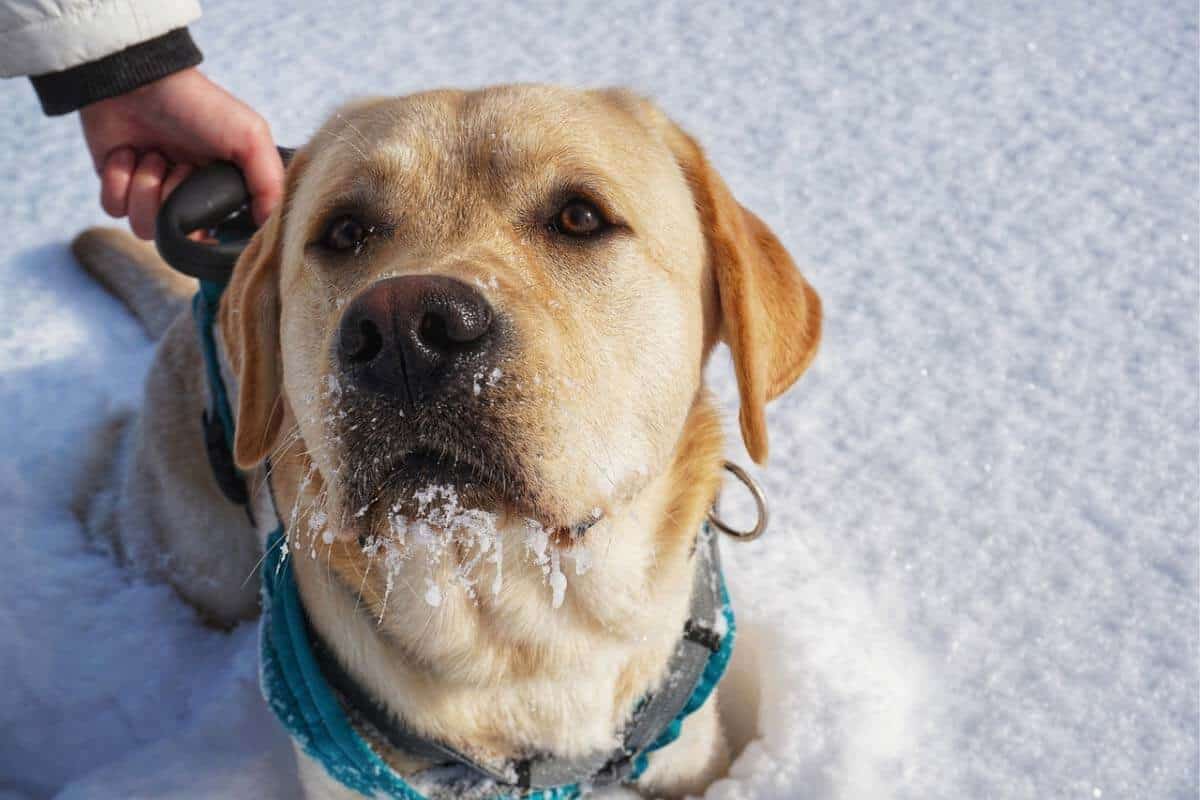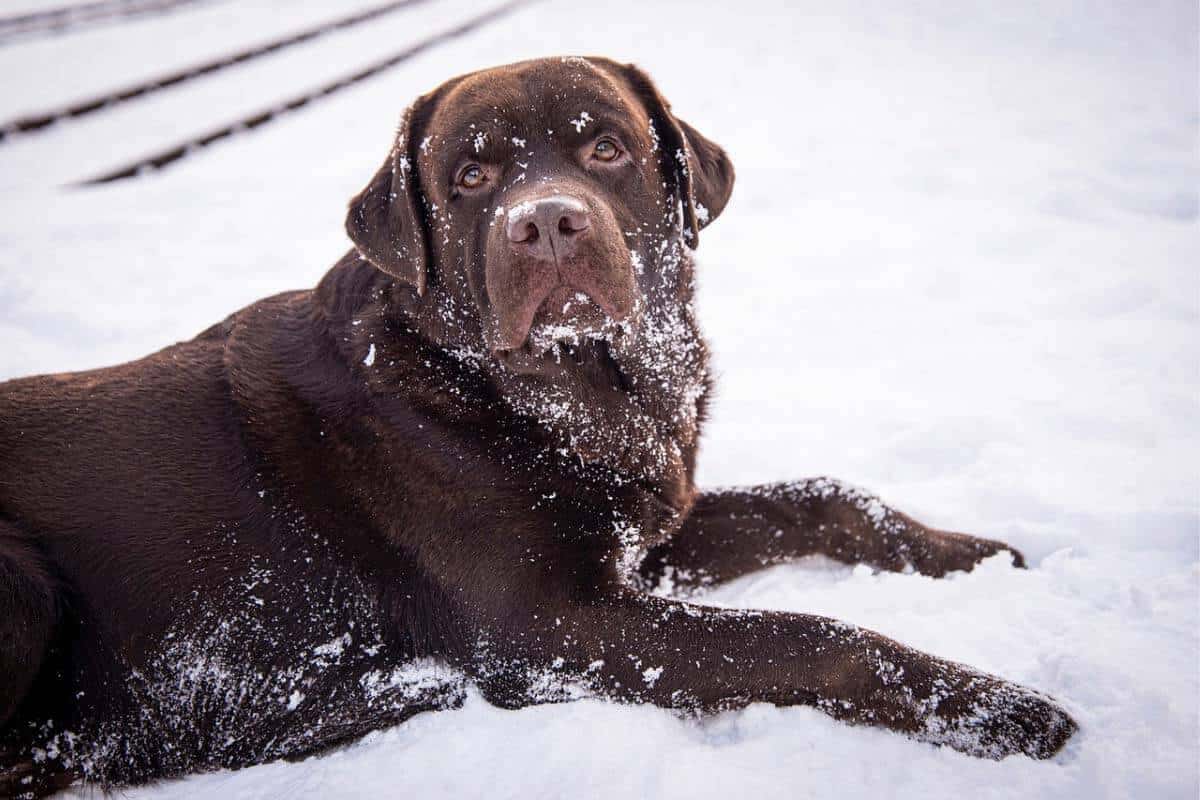Labradors’ intellect, loyalty, and friendliness make them one of the most adored dog breeds. But how well do they cope with the cold? This post examines Labradors’ endurance for various temperatures and the dangers of keeping them outside in the cold.
The properties of the Labrador coat, the best temperature range for Labradors, and the risks of wind chill and frostbite will all be covered. We’ll also offer some advice on how to keep your Labrador warm and secure during the chilly months.
A comfortable temperature for most Labradors is between 20 and 77 degrees Fahrenheit. Shivering and tiredness are likely to appear in Labradors when the temperature drops below 20 degrees. Labradors shouldn’t be left outside for more than a few minutes in temperatures below 20 degrees Fahrenheit.
The endurance of Labradors to various temperatures as well as the dangers of leaving them outside in the cold, are discussed in this article.
We will go through the features of the Labrador’s coat that make it possible for them to withstand colder temperatures, the best temperature range for Labradors, and the dangers of wind chill and frostbite.
We’ll also offer some advice on how to keep your Labrador warm and secure during the chilly months. Finally, we’ll look at potential natural dangers affecting a Labrador’s capacity for cold tolerance.

How Cold Can Labradors Tolerate Outside?
Popular dog breeds like labradors are renowned for their intellect, sociability, and vibrant personalities. Although each dog is different, Labradors can withstand colder conditions better than most other breeds. However, how cold can Labradors stand outside?
In inclement weather, Labradors’ thick double coat helps keep them warm. This coat is made up of an outer layer of longer, wavy fur and an interior layer of short, dense fur.
The dog is shielded from the elements and has their body temperature regulated by this protective layer. Additionally, Labradors have webbed feet, improving their swimming abilities and keeping them warmer in chilly water.
Although Labradors can withstand temperatures below zero, they become increasingly uncomfortable as the temperature drops. A comfortable temperature for most Labradors is between 20 and 77 degrees Fahrenheit.
If you’re gradually introducing your Labrador to colder temperatures, consider using a paw balm to protect their paws from ice and salt.
Shivering and tiredness are likely to appear in Labradors when the temperature drops below 20 degrees. Labradors shouldn’t be left outside for more than a few minutes in temperatures below 20 degrees Fahrenheit.
Due to their sensitivity to wind chill, labradors are more uneasy as the wind gets colder. Keeping your Labrador warm and dry outside is crucial for this reason. Keep your Labrador indoors if the wind chill is less than 20 degrees Fahrenheit.
Your Labrador can be outside for a brief period if the wind chill is between 20 and 77 degrees, but you should bring them inside as soon as they begin to shiver.
Frostbite happens when freezing temperatures harm the skin and, occasionally the underlying tissue.
The ears, nose, tail, and feet are the body parts most prone to frostbite, so it’s crucial to keep them warm and covered while it’s cold outside. If labradors are exposed to low conditions for an extended period, they can potentially develop frostbite.
In summary, Labradors can withstand colder conditions than most other breeds, but they shouldn’t be left outside in wind chills or temperatures below 20 degrees Fahrenheit.
To avoid frostbite, keeping their feet, noses, tail, and ears warm and dry is crucial. Labradors can enjoy the outdoors with the proper care and attention, even in colder weather.
f your lab has a medical condition and is not feeling well enough to go out in the cold, you might want to consider purchasing some indoor training pads to keep your pup from having to go outside in the harsh weather
Labradors’ Tolerance to Temperature
Compared to most other breeds, labradors are typically seen as a breed that can withstand colder conditions better.
This results from their heavy double coat, which has an exterior layer made of long, wavy fur and an interior layer of short, thick fur. The dog is shielded from the elements and has better control over body temperature thanks to its second layer.
Labradors can typically withstand temperatures below zero, but the colder it gets, the less comfortable they are.
A comfortable temperature for most Labradors is between 20 and 77 degrees Fahrenheit. Shivering and tiredness are likely to appear in Labradors when the temperature drops below 20 degrees.
When your Labrador is outside, it is crucial to keep them warm and dry. Labradors should be for a maximum of a few minutes in temperatures below 20 degrees Fahrenheit. Due to their sensitivity to wind chill, labradors are more uneasy as the wind gets colder.
| Minimum | Ideal | Maximum | |
| Normal dog | 50°F (10°C) | 65 – 72°F (18.3 to 22.2°C) | 85°F (29.5°C) |
| Puppy Labrador | 25°F (-7°C) | 50 – 77°F (10 to 25°C) | 86°F (30°C) |
| Adult Labrador | 20°F (-6,6°C) | to 77°F. (0 to 25°C) | 90°F (32,2°C) |

At What Temperature Should I Bring My Lab Inside?
Knowing when to bring your Lab inside can ensure their safety and comfort throughout the colder months. When the temperature dips below 20°F (-7°C), Labradors should be brought inside. When choosing the appropriate time to get your Lab inside, keep in mind other aspects besides temperature.
These elements include the age, health, kind of coat, and level of activity of your Labrador. Adult, healthy Labradors should be brought inside at a lower temperature than puppies, the elderly, and those with health issues.
Although Labradors with double coats can typically withstand colder weather than single coats, bringing them inside when the temperature dips below freezing is still crucial.
If your Lab is very active, you should bring them inside at a warmer temperature than usual because they will produce more body heat and be more prone to become cold. Considering these aspects, it is crucial to bring your Lab inside when it gets below 20°F (-7°C) to keep them safe and happy.
If you notice any of these signs, bring your Labrador inside immediately and warm them up. A cozy dog bed or a warm blanket can help them recover quickly.
Do Labradors Require Coats During the Winter? Which types of coats are available for Labradors?
In cold weather, labradors require coats to keep warm and cozy. The Labrador should be able to move around and stretch out comfortably in the coat, which should also be snugly fitting, waterproof, and windproof. Straw and blankets can also be put outside shelters to offer additional warmth.
Labradors can wear various clothing, including waterproof and windproof coats, insulated jackets, and sweaters. It’s crucial to ensure that the Labrador’s coat fits them correctly and is roomy enough to stretch out. A blanket or straw can also be used to add additional layers of warmth.
Consider your area’s weather and your Labrador’s activity level when choosing a coat. Consider getting your Labrador a coat with extra insulation if you live in a chilly climate so they stay warm. Look for a lightweight and breathable coat for highly active labradors to keep them calm while offering warmth.
While their double coat offers impressive insulation, it’s essential to provide extra protection in freezing temperatures. One way to do this is by ensuring they have a warm, insulated dog house for outdoor breaks.
Lastly, because labradors may be highly energetic, ensure the coat is simple to put on and take off. You want to save time trying to get them into the coat because they can be pretty busy. Your Labrador can always keep warm and dry with the correct coat.
You should make sure that your Labrador has access to enough shelter, blankets, or straw when it’s chilly outside, in addition to choosing the proper coat for them. This will keep your Labrador cozy and toasty during the cold months.
Additionally, it’s critical to keep your Labrador hydrated and provide for a balanced, wholesome diet.
Your Labrador can stay dry and warm in cold weather with the right coat and care. They will be able to withstand the cold weather better and maintain a healthy immune system. Additionally,
it’s crucial to ensure your Labrador gets enough exercise because this keeps their muscles strong and helps maintain a healthy body temperature, both of which can help them stay warm in cold weather.
The Differences in Tolerance to Cold Temperatures Between Labradors and Other Breeds
It’s crucial to remember that people, not only breeds, might have different levels of tolerance for low weather.
However, due to their thick double coat, Labradors are typically thought to have a stronger tolerance for cold temperatures than other breeds.
In order to keep them warm in colder climates, this coat is made up of an inside layer of short, compact fur and an exterior layer of longer, wavy fur. Labradors also have webbed feet, which aid in keeping them warmer in chilly water.
The Malamute, Samoyed, and Bernese Mountain Dogs are three breeds with thick coats that may be more tolerant to cold conditions than other breeds.
Senior Labs may benefit from a supportive, orthopedic dog bed to ease joint pain, which can be exacerbated by cold weather.
In conclusion, Labradors are exceptionally hardy and can withstand freezing weather with the proper care and protection. Ensure that they have warm clothing, suitable shelter, plenty of water, and a nutritious and balanced meal.
Give your Labrador lots of exercises to help them maintain a healthy body temperature and build stronger muscles.
Consider buying your dog a winter coat that is waterproof, windproof, and big enough for them to roam around and stretch out if you live somewhere with icy winters. Your Labrador can stay dry and toasty in chilly weather with the proper care.
Can I use a human heating pad for my dog?
It’s not recommended to use a human heating pad for your dog as they can get too hot and pose a burn risk. Instead, opt for a heating pad specifically designed for pets. These pads have safety features like lower maximum temperatures and chew-resistant cords.
How can I tell if my Labrador’s dog house is warm enough in the winter?
A good dog house should be well-insulated and the right size for your Lab—large enough to stand up and turn around in, but small enough to retain body heat. You can check the temperature inside the doghouse with a thermometer. Ideally, it should be significantly warmer than the outside air. Adding a pet-safe heating pad or lamp designed for dog houses can provide extra warmth. You should also make sure the bedding is thick, dry, and made of insulating material like straw or cedar shavings. Avoid using blankets in an outdoor, unheated doghouse, as they can get wet and freeze. Consider a dog house door flap to keep out drafts and precipitation.
Is it okay to shave my Labrador in the winter to prevent matting?
No, it’s generally not recommended to shave your Labrador in the winter. Their double coat provides crucial insulation against the cold. Shaving them can make them more susceptible to hypothermia. Regular brushing is the best way to prevent matting and keep their coat healthy. If your Lab has severe matting that you can’t remove yourself, consult a professional groomer for advice.
What are some indoor activities I can do with my Labrador when it’s too cold to go outside?
A: There are plenty of fun ways to keep your Lab entertained indoors! You can try: Puzzle toys: These toys challenge your dog mentally and can keep them occupied for a long time. (Consider linking “puzzle toys” to a selection on Amazon.)
Hide-and-seek: Hide treats or toys around the house and let your Lab find them.
Indoor training: Practice obedience commands or teach your Lab new tricks.
Tug-of-war: A classic game that provides physical and mental stimulation. (Consider linking “tug-of-war” to a durable dog toy on Amazon.)
Indoor fetch (with caution): If you have enough space, you can play a gentle game of fetch indoors with a soft toy.
How much exercise does my Labrador need in the winter?
Labradors are an active breed and still need regular exercise even in cold weather. The amount of exercise will depend on your dog’s age, health, and individual tolerance to the cold. Even on very cold days, try to provide at least two shorter walks instead of one long one. You can also supplement outdoor exercise with indoor play and training. On days when it is too cold for your Lab to be outside, consider indoor training pads.
My Labrador loves to eat snow. Is this safe?
While a little bit of clean snow is unlikely to harm your Labrador, it’s best to discourage them from eating large quantities. Snow can contain hidden objects, chemicals (like de-icing salt), or pollutants that could be harmful. Eating too much snow can also lower their body temperature and potentially cause an upset stomach. Provide your dog with fresh, clean water to discourage them from eating snow.
Can puppies tolerate cold weather the same as adult Labradors?
No, Labrador puppies are much more vulnerable to cold than adult dogs. They have less body fat and less developed coats, making it harder for them to regulate their body temperature. Keep young puppies indoors as much as possible during very cold weather, and limit their outdoor time to very short potty breaks. Provide them with a warm, comfortable place to sleep inside, away from drafts. A cozy dog bed designed for puppies is a great investment.



